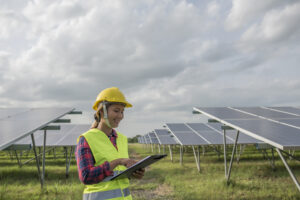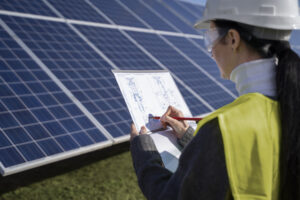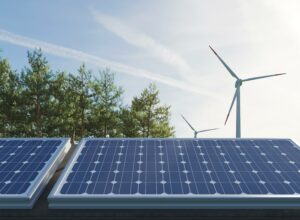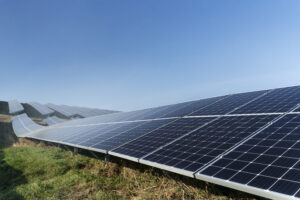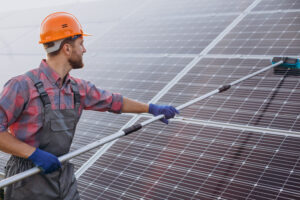The boon of sustainability cannot be complete without the harnessing of the ever-present solar energy. In my professional and personal life, there are people who are aware of solar energy solutions and want to set up such systems in their homes and businesses. But the question is which solar energy system is best for my house or business. Well, I have done my research and the table below will give you an overall view of the solar energy systems available today. For more details keep reading this blog.
| Type of Solar Energy System | How it Works | Advantages | Disadvantages | Best For | Upfront Cost | Energy Storage Required | Maintenance Level | Efficiency |
| Grid-Tied Solar System | Connected to the electrical grid, sends excess power back to the grid. | Lower costs, no need for battery storage, net metering. | No power during grid outages without battery backup. | Urban areas with reliable grid access. | Low | No | Low | High in Urban Areas |
| Off-Grid Solar System | Operates independently from the grid, relies on battery storage. | Energy independence; no reliance on the grid. | Higher costs due to batteries require careful energy management. | Remote areas without grid access. | High | Yes | Medium | High in Remote Areas |
| Hybrid Solar System | Combination of grid-tied and off-grid with battery backup. | Backup power during outages, can sell excess energy. | Higher costs, complex installation and maintenance. | Homes and businesses seeking energy security. | Medium | Yes (Optional) | Medium | High in All Areas |
| Solar Thermal System | Uses sunlight to heat water or air, not for electricity. | Efficient for heating, low maintenance. | Only for heating, not electricity generation. | Homes and businesses with heating needs. | Medium | No | Low | High for Heating Only |
| Concentrated Solar Power (CSP) | Uses mirrors/lenses to focus sunlight for electricity generation. | Large-scale power production can store energy as heat. | Requires large space, high upfront costs. | Large businesses or industrial applications. | High | Yes | High | High for Industrial Use |
Grid-Tied Solar Energy Systems
A grid-tied solar system is one that connects with the public electricity grid. The grid-tied solar system gives you flexibility in using electricity. It generates electricity with the help of the solar power system, but it also has access to the public electricity grid and gets electricity from that when the solar power system is not working.
How it works?
The solar panels capture the natural sunlight and create DC electricity, and then the inverter converts it into AC electricity. The AC electricity powers the home or business that connects to it. The extra electricity that the solar panels use is given back to the electricity grid. The power grid remains connected to the house power system and offers electricity when the solar panels are not generating any current.
Advantages
- The grid-tied solar energy systems are beneficial because they are low-cost to set up and can work easily with any house or business setup.
- The excess energy that the system generates can be sold to the grid through a process of net metering. This creates an electricity credit, and you get a reduced power bill from the power system.
Disadvantages
- While a grid-tied solar power system works smoothly, the system is still tied to the grid, and the house will be dependent on the grid to some extent.
- While the solar panels create electricity, the grid-tied system does not give you a power backup for power cuts until you combine the solar panel system with a battery that stores the excess electricity.
- Ideal for: The Grid Tied Solar Energy Systems is very ideal for urban homes and businesses that do not face frequent power cuts and have stable connections with the power grid.
Off-Grid Solar Energy Systems
An off-grid solar energy system works without connection with the grid and is self-sufficient in its working. This is a power system you set up when you want to save electricity and create a fully automatic power system. This system is a fully independent and renewable power system for homes and businesses. It is also one that has a power backup so that the home has access to power even when there is no access to sunlight for continuous power generation.
How it works?
Apart from solar panels, the off-grid solar energy system also has a charge controller that regulates the flow of electricity from the solar panels to the inverter and battery pack. The charge controller ensures that the solar panels do not overcharge the battery storage. Many of the off-grid solar energy systems also come with a backup generator which can provide power when there is no sunlight.
Advantages
- An off-grid solar power system is a renewable source of energy independence. Once this electricity generation system is in place, the home or business does not depend on the public grid.
- If there are homes and businesses that run in remote areas and have no or limited access to the electricity grid, then an off-grid system of solar energy generation is a good option.
Disadvantages
- The upfront costs to set up an off-grid solar energy system is higher than the grid-tied one as it also includes the price of the batteries and generator needed for power backup. So, it is not the most affordable solution in the short term.
- To deploy the off-grid solar energy system, you need to use a strategy for smart power management and saving tips so that you can maximise its use to a great extent.
- Ideal for: The off-grid solar energy system is ideal for use in case of businesses that are set in remote areas or even for residences that are situated in remote access areas.
Hybrid Solar Energy Systems
A hybrid solar energy system has a mix of power generation and backup options. It offers grid backup and also power storage. However, it also remains connected to the public power grid. Therefore, it is a robust and flexible solution that has multiple power backup options.
How it works?
The solar panels capture the sunlight and help in the conversion of the photons to direct current. The connected inverter then converts the DC electricity to AC form so the establishment can use it properly. There is a battery storage that keeps the power stored and provides backup when the sun does not shine strongly. If the power reserves from the battery run low, the grid provides the backup connection.
Advantages
- The hybrid power generation system minimises the chances of power failure as it has solar energy backup in a battery and also has a grid supply. So, there is uninterrupted power to the building.
- The surplus electricity and power can be sold to the public grid through a net metering process.
Disadvantages
- The hybrid solar energy system is costlier than other options because it has to create a grid connection and also has a backup battery. So, the set-up costs can be high for a household or business.
- As there are multiple connections to be made, you need to invest in the complex process. The setup and maintenance of this system is very complex and time-consuming.
- Ideal for: It is ideal for highly functional homes and businesses that want to secure the electricity supply they get so there are no power cuts.
Solar Thermal Systems
A solar thermal system does not use the solar energy from the sun to generate electricity, but it harnesses thermal energy from the sun’s heat. Solar thermal collectors are the parts that absorb the sun’s heat and amplify the thermal energy to warm a liquid like water.
How it works?
The solar collectors that harness the thermal energy are either plates or tubes. The flat plate collectors offer a large surface area and are used to create thermal energy that can heat water for residential use. Tube collectors create a vacuum and harness thermal energy with minimal heat loss. The tube collectors in solar thermal systems are apt for colder climate buildings or extensive thermal energy use in large buildings and businesses. There is a heat transfer liquid that circulates in closed-loop systems and collects the heat from the collectors. The liquid then goes to a heat exchanger, where the heat transfers to water for water heating. This water keeps circulating around the heat collectors to ensure that there is no loss of fluid.
Advantages
- The solar thermal system is ideal for water heating and pool heating systems in a sustainable way.
- Such a thermal system does not cost too much to set up or maintain. The solar thermal system is durable and lasts for years.
Disadvantages
- While the solar thermal system is advantageous for heating purposes, there is no electricity generation. Therefore, if you have the goal of getting electricity from solar energy, then this is not the right choice.
- The thermal system is extensive with a set of collectors, a storage tank for the water, and a heat exchanger for the heat transfer to the fluid. Since it has many components, it takes time and space to set up.
- Ideal for: The solar thermal system is an ideal setup for your home or business if there is daily water heating and other thermal needs. For example, hotels and huge villas can opt for this system for heating purposes.
Conclusion
There are different types of solar energy systems available in the market, and I suggest the brand GSL Energy Solutions for any purchase. You can get so many options at GSL Energy Solutions in Kerala and choose the right system for your needs. They are well known for creating sustainable and affordable solar energy solutions for residential and commercial clients. You can always browse through their energy solutions and pick the best for your business or residence. They offer many services and real-time support for the set up and maintenance of solar energy solutions.


